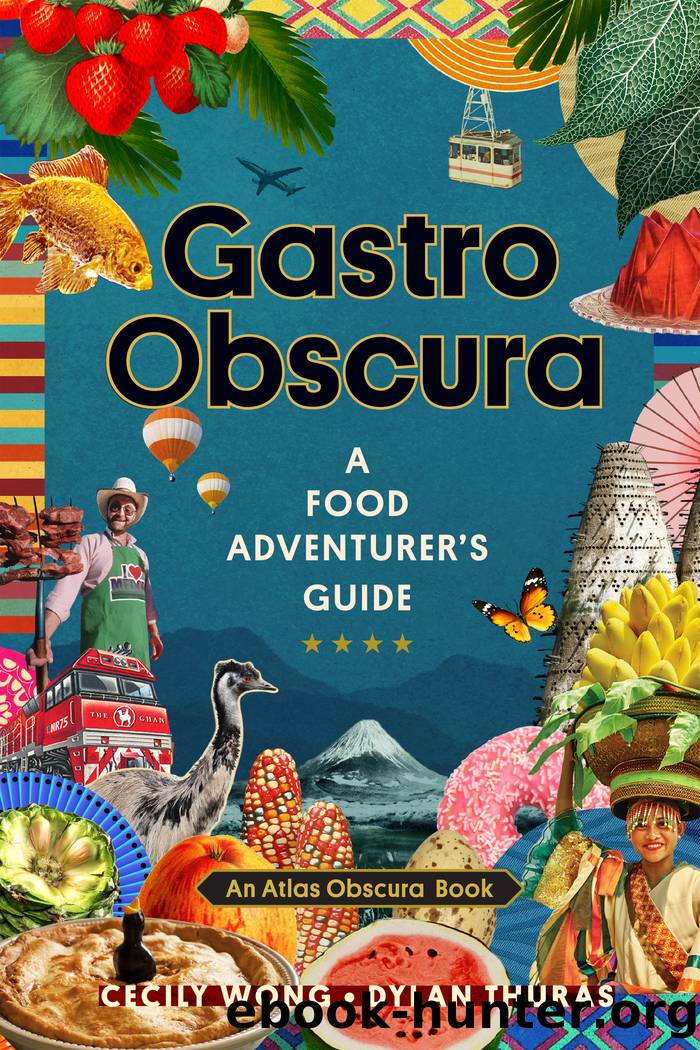Gastro Obscura by Cecily Wong

Author:Cecily Wong
Language: eng
Format: epub
Publisher: Workman Publishing Company
Published: 2021-06-15T00:00:00+00:00
How to try it
Free Range Emu Farm is located at 681 Clackline Road in Toodyay, Western Australia. It is open to the public every day from 10 a.m. to 4 p.m., and visitors can purchase emu meat, eggs, oil, feathers, and even live chicks.
Emus are the second tallest bird in the world, outranked only by the ostrich.
How Australia Came to Have the Largest Feral Camel Population in the World
In the 19th century, British colonists were stumped by the desert expanse of Australiaâs vast interior. Was it flat or mountainous? Dry or a giant inland sea? European modes of transportation, like horses, werenât suited to the new terrain and early expeditions were unsuccessful. But a solution arrived from elsewhere in the empire: Camels, which the British encountered in colonial India, were an ideal solution for traversing the dry, rugged island.
In 1858, the Victorian Exploration Committee tasked horse dealer George Landells with recruiting camels and their drivers from India and bringing them to Australia. Over the next few decades, an estimated 20,000 camels were imported to the continent, along with about 3,000 camel handlers, who together enabled the settlement of Australiaâs interior. The hardy, steady animals could trek for hours under brutal sun with little water, and they became integral to the overland network of goods, labor, and infrastructure. But the Muslim migrantsâdubbed âAfghan cameleersâ by white Australians, despite not always being from Afghanistanâwere the target of rampant discrimination.
On January 1, 1901, Australia became an independent country and enacted a set of new, decidedly racist immigration laws. Collectively called the White Australia policy, these laws halted almost all nonwhite immigration, and by the 1920s, the vast majority of cameleers had fled the country. Left behind, some of the camels were shot under the South Australian Camels Destruction Act of 1925. Others were released into the wild, where their descendants continue to live today.
Australia is now home to the largest feral camel population in the world, with estimates around one million. Left to roam, the animals pose a threat to delicate native ecosystems and water supplies. The Australian government has sponsored aerial camel culls in which feral camels are shot down by helicopter. But many argue for another solution: use the animals as food.
The Australian market for camel meat is growing, but its success hinges on capturing the camels and transporting them to processing facilities, which is expensive. The lean meat, which many people liken to a cross between lamb and beef, is sold to many Middle Eastern and North African countries and their diaspora communities. The animals are typically processed at an abattoir, and the meat is distributed to butchers both domestic and international.
Download
This site does not store any files on its server. We only index and link to content provided by other sites. Please contact the content providers to delete copyright contents if any and email us, we'll remove relevant links or contents immediately.
Spell It Out by David Crystal(35992)
Underground: A Human History of the Worlds Beneath Our Feet by Will Hunt(11981)
A Year in the Merde by Stephen Clarke(5263)
Venice by Jan Morris(2496)
Claridge's: The Cookbook by Nail Martyn & Erickson Meredith(2318)
My Paris Kitchen: Recipes and Stories by Lebovitz David(2168)
A TIME OF GIFTS by Patrick Leigh Fermor(2135)
The Plantagenets by Dan Jones(1973)
Welcome to the Goddamn Ice Cube by Blair Braverman(1933)
Top 10 Prague (EYEWITNESS TOP 10 TRAVEL GUIDES) by DK(1900)
Bang Poland: How To Make Love With Polish Girls In Poland by Roosh V(1895)
The Isle of Mull by Terry Marsh(1866)
The Finnish Way by Katja Pantzar(1853)
From Russia with Lunch by David Smiedt(1850)
A TIME TO KEEP SILENCE by Patrick Leigh Fermor(1810)
Rick Steves London 2018 by Rick Steves & Gene Openshaw(1794)
A Taste of Paris by David Downie(1781)
Merde in Europe by Stephen Clarke(1701)
Insight Guides Experience Tokyo by Insight Guides(1689)
